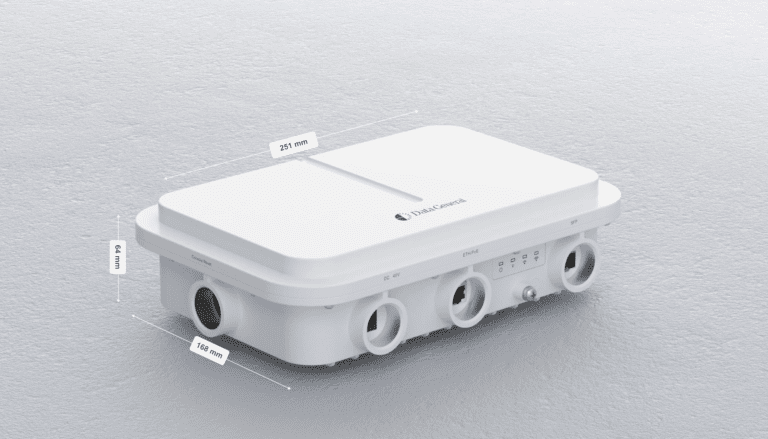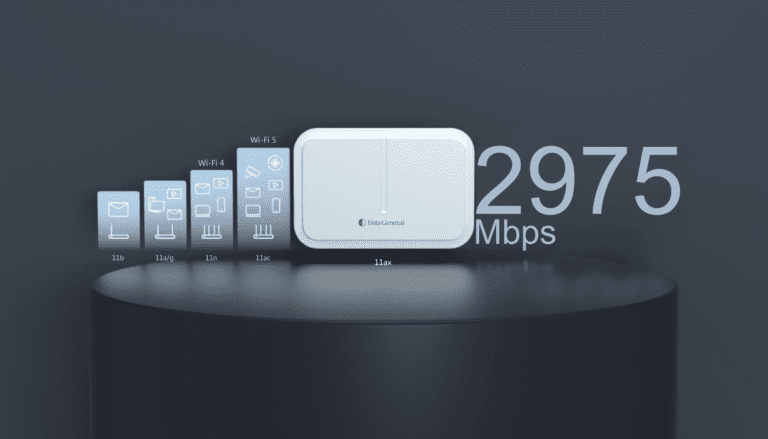Outdoor IP68 WiFi 6 Omni antenna Access Point
DG-AP680-AX3000-O
- Outdoor and indoor access point
- 2976 Mbps aggregated
- WiFi 6 802.11ax
- Dual 2.4 GHz and 5 GHz radio
- 1 RJ45 gigabit and 1 SFP 2.5 Gbps
- IP68 weathering resistance
- Internal omni-directional antenna
Extreme environments Omni AP
The DG-AP680-AX3000-O WiFi 6 Access Point from Data General is engineered to perform in extreme environments, including those with high humidity, dust, or temperature challenges, all while providing reliable omnidirectional coverage.
Constructed with a durable aluminum body and rated IP68 for weatherproof protection, this access point is designed to operate in temperatures ranging from -40ºC to +65ºC. Equipped with 802.11ax dual-radio technology (2.4 GHz and 5 GHz), it delivers an impressive aggregate wireless speed of up to 2976 Mbps. Additionally, it features a gigabit Ethernet port and a 2.5 Gbps SFP port, enabling long-distance installation via optical fiber.
With its robust performance and versatile features, the DG-AP680-AX3000-O is ideal for industrial facilities, outdoor hotel areas, warehouses, university campuses, large events, or any environment requiring reliable connectivity in extreme conditions.







- Outdoor and indoor access point.
- Protocols: 802.11a/b/g/n/ac/ax WiFi 6.
- Dual radio: 2.4 GHz (2×2) and 5 GHz (2×2).
- Aggregate speed of 2976 Mbps.
- 1 RJ45 5 Gbps port, 1 SFP combo 2.5 Gbps port.
- IP68 industrial grade design.
- Internal Omnidirectional Antenna (zenithal)
- Up to 1024 STAs (devices) and 32 virtual APs.
- Power over PoE (802.3at) or external power supply (48v. 0.6 A).
- Individual management via Web (FAT), via WIS Cloud (FIT) or via local AC controller (FIT).
| Hardware Specifications | |
|---|---|
| 802.11n | Four spatial streams |
| ● Radio 1 – 2.4 GHz: 2×2 MIMO, two spatial streams | |
| ● Radio 2 – 5 GHz: 2×2 MIMO, two spatial streams | |
| Channels: | |
| ● Radio 1 – 2.4 GHz: 20 MHz and 40 MHz | |
| ● Radio 2 – 5 GHz: 20 MHz and 40 MHz | |
| Combined peak data rate: 600Mbps | |
| ● Radio 1 – 2.4 GHz: 6.5 Mbps to 300 Mbps (MCS0 to MCS15 ) | |
| ● Radio 2 – 5 GHz: 6.5 Mbps to 300 Mbps (MCS0 to MCS15) | |
| Radio technologies: Orthogonal Frequency-Division Multiplexing (OFDM) | |
| Modulation types: BPSK, QPSK, 16-QAM, 64-QAM, 256-QAM | |
| Packet aggregation: | |
| ● Aggregate MAC Protocol Data Unit (A-MPDU) | |
| ● Aggregate MAC Service Data Unit (A-MSDU) | |
| Dynamic Frequency Selection (DFS) | |
| Cyclic Delay/Shift Diversity (CDD/CSD) | |
| Maximum Ratio Combining (MRC) | |
| Space-Time Block Coding (STBC) | |
| Low-Density Parity Check (LDPC) | |
| Transmit beam-forming (TxBF) | |
| 802.11ac | Two spatial streams |
| ● Radio 2 – 5 GHz: 2×2 MIMO, two spatial streams | |
| Channels: | |
| ● Radio 2 – 5 GHz: 20 MHz, 40 MHz, 80 MHz, and 160 MHz | |
| Combined peak data rate: 1.733 Gbps | |
| ● Radio 2 – 5 GHz: 6.5 Mbps to 1.733 Gbps (MCS0 to MCS9) | |
| Radio technologies: Orthogonal Frequency-Division Multiplexing (OFDM) | |
| Modulation types: BPSK, QPSK, 16-QAM, 64-QAM, 256-QAM, 1024-QAM | |
| Packet aggregation: | |
| ● Aggregate MAC Protocol Data Unit (A-MPDU) | |
| ● Aggregate MAC Service Data Unit (A-MSDU) | |
| Dynamic Frequency Selection (DFS) | |
| Cyclic Delay/Shift Diversity (CDD/CSD) | |
| Maximum Ratio Combining (MRC) | |
| Space-Time Block Coding (STBC) | |
| Low-Density Parity Check (LDPC) | |
| Transmit beam-forming (TxBF) | |
| 802.11ax | Four spatial streams |
| ● Radio 1 – 2.4 GHz: 2×2 uplink/downlink MU-MIMO, two spatial streams | |
| ● Radio 2 – 5 GHz: 2×2 uplink/downlink MU-MIMO, two spatial streams | |
| Channels: | |
| ● Radio 1 – 2.4 GHz: 20 MHz and 40 MHz | |
| ● Radio 2 – 5 GHz: 20 MHz, 40 MHz, 80 MHz, and 160 MHz | |
| Combined peak data rate: 2.976 Gbps | |
| ● Radio 1 – 2.4 GHz: 8.6 Mbps to 0.574 Gbps (MCS0 to MCS11) | |
| ● Radio 2 – 5 GHz: 8.6 Mbps to 2.402 Gbps (MCS0 to MCS11) | |
| Radio technologies: uplink/downlink Orthogonal Frequency-Division Multiple Access (OFDMA) | |
| Modulation types: BPSK, QPSK, 16-QAM, 64-QAM, 256-QAM, 1024-QAM | |
| Packet aggregation: | |
| ● Aggregate MAC Protocol Data Unit (A-MPDU) | |
| ● Aggregate MAC Service Data Unit (A-MSDU) | |
| Dynamic Frequency Selection (DFS) | |
| Cyclic Delay/Shift Diversity (CDD/CSD) | |
| Maximum Ratio Combining (MRC) | |
| Space-Time Block Coding (STBC) | |
| Low-Density Parity Check (LDPC) | |
| Transmit beam-forming (TxBF) | |
| WPA3 | |
| Antenna | Wi-Fi |
| ● 2.4 GHz: two built-in omnidirectional antennas, the max. antenna gain is 4 dBi. | |
| ● 5 GHz: two built-in omnidirectional antennas, the max. antenna gain is 6 dBi. | |
| Bluetooth | |
| ● One integrated vertically polarized omnidirectional antenna, the max. antenna gain is 5 dBi. | |
| Port | 1 x 100/1000Base-T RJ45 Ethernet port with auto-negotiation |
| 1 x 2.5GE SFP port | |
| 1 x RJ45 console port (serial console port) | |
| 1 x Bluetooth 5.0 | |
| Status LED | 1 x multi-color system status LED |
| ● AP power-on status | |
| ● Software initialization status and upgrade status | |
| ● Uplink service interface status | |
| ● Wireless user online status | |
| ● CAPWAP tunnel timeout | |
| ● Specific AP locating | |
| Three single-color signal strength LEDs: | |
| ● Whether bridging is enabled | |
| ● Whether bridging is successful | |
| ● Wireless signal strength after successful bridging | |
| Button | 1 x Reset button |
| ● Press the button for shorter than 2 seconds. Then the device restarts. | |
| ● Press the button for longer than 5 seconds. Then the device restores to factory settings. | |
| Dimensions (W x D x H) | Main unit: 251 mm x 168 mm x 64 mm (9.88 in. x 6.61 in. x 2.52 in.) |
| Shipping: 405 mm x 232 mm x 325 mm (15.94 in. x 9.13 in. x 12.80 in.) | |
| Weight | Main unit: 1.0 kg (2.2 lbs) |
| Mounting bracket: 0.9 kg (1.98 lbs) | |
| Shipping: 3.15 kg (6.94 lbs) | |
| Mounting | Wall or Pole-mounting (a mounting bracket is delivered with the main unit) |
| Input power supply | The AP supports the following two power supply modes: |
| ● 48 V DC/0.35 A power input over DC connector: The DC connector accepts the center-positive circular plug with the inner diameter of 2.0 mm (0.08 in.) or outer diameter of 6.3 mm (0.25 in.) and the length of 9.8 mm (0.39 in.). A DC power supply needs to be purchased independently. | |
| ● PoE input over ETH/PoE: The power source equipment (PSE) complies with IEEE 802.3af/at standard (PoE/PoE+). | |
| Note: If both DC power and PoE are available, DC power is preferred. | |
| Power consumption | Maximum power consumption: 12.95 W |
| ● DC power: 12.95 W | |
| ● 802.3at (PoE+): 12.95 W | |
| ● 802.3af (PoE): 12.95 W | |
| ● Idle mode: 6.0 W | |
| Environment | Storage temperature: –40°C to +85°C (–40°F to +185°F) |
| Storage humidity: 0% RH to 100% RH (non-condensing) | |
| Storage altitude: < 5,000 m (16,404.20 ft.) at 25°C (77°F) | |
| Operating temperature: –40°C to +65°C (-40°F to +149°F) | |
| Operating humidity: 0% RH to 100% RH (non-condensing) | |
| Operating altitude: < 5,000 m (16,404.20 ft.) at 55°C (131°F) | |
| At an altitude between 3,000 m (9,842.52 ft.) and 5,000 m (16,404.20 ft.), every time the altitude increases by 166 m (546 ft.), the maximum temperature decreases by 1°C (1.8°F). | |
| IP Rating | IP68 |
| Mean Time Between Failure (MTBF) | 200,000 hours (22 years) at the operating temperature of 25°C (77°F) |
| System memory | 512 MB DRAM, 128 MB flash |
| Transmit power | 2.4 GHz |
| ● Max. transmit power: 28 dBm (630.96 mW) | |
| ● Minimum transmit power: 10 dBm (10 mW) | |
| 5 GHz | |
| ● Max. transmit power: 28 dBm (630.96 mW) | |
| ● Minimum transmit power: 10 dBm (10 mW) | |
| Note: The transmit power adjusted in percentage. The transmit power is limited by local regulatory requirements. | |
| Software Specifications | |
| Basic Function | |
| Applicable software version | RGOS11.9(6)W2B4 or later |
| WLAN | |
| Max. number of associated STAs | 1,024 (up to 512 STAs per radio) |
| Max. number of BSSIDs | 32 (up to 16 BSSIDs per radio) |
| Max. number of WLAN IDs | 16 |
| STA management | SSID hiding |
| Each SSID can be configured with the authentication mode, encryption mechanism, and VLAN attributes independently. | |
| Remote Intelligent Perception Technology (RIPT) | |
| Intelligent STA identification | |
| Intelligent load balancing based on the STA quantity or traffic | |
| STA limiting | SSID-based STA limiting |
| Radio-based STA limiting | |
| Bandwidth limiting | STA/SSID/AP-based rate limiting |
| CAPWAP | IPv4/IPv6 CAPWAP |
| Layer 2 and Layer 3 topology between an AP and an AC | |
| An AP can automatically discover the accessible AC. | |
| An AP can be automatically upgraded through the AC. | |
| An AP can automatically download the configuration file from the AC. | |
| CAPWAP through NAT | |
| Data forwarding | Centralized and local forwarding |
| Wireless roaming | Layer 2 and Layer 3 roaming |
| Wireless locating | MU and TAG device locating |
| Security and Authentication | |
| Authentication and encryption | Remote Authentication Dial-In User Service (RADIUS) |
| PSK and web authentication | |
| QR code-based guest authentication, SMS authentication, and MAC address bypass (MAB) authentication | |
| Data encryption: WEP (64/128 bits), WPA (TKIP), WPA-PSK, WPA2 (AES) | |
| Data frame filtering | Allowlist, static blocklist, and dynamic blocklist |
| WIDS | Rogue device discovery |
| Optimization of rogue AP containment for all STA types | |
| Fuzzy containment | |
| SSID-based blocklist | |
| DDoS attack identification | |
| Automatic detection of STA attacks, and adding STAs to the blocklist when ICMP attacks or TCP SYN attacks are detected | |
| STA isolation | |
| ACL | IP standard ACL, MAC extended ACL, IP extended ACL, and expert-level ACL |
| IPv6 ACL | |
| Time range-based ACL | |
| ACL based on a Layer 2 interface | |
| ACL based on a Layer 3 interface | |
| Ingress ACL based on a wireless interface | |
| Dynamic ACL assignment based on 802.1X authentication (used with the AC) | |
| CPP | CPU Protect Policy (CPP) |
| NFPP | Network Foundation Protection Policy (NFPP) |
| Routing and Switching | |
| MAC | Static and filtered MAC addresses |
| MAC address table size: 1,024 | |
| Max. number of static MAC addresses: 1,024 | |
| Max. number of filtered MAC addresses: 1,024 | |
| Ethernet | Jumbo frame length: 1,518 |
| Ethernet II | |
| 1000M SFP ports modules | |
| 2.5G ports | |
| VLAN | Interface-based VLAN assignment |
| Layer 2 isolation of wired interfaces (including aggregate interfaces) within VLANs | |
| Max. number of SVIs: 191 | |
| Max. number of VLANs: 4,094 | |
| VLAN ID range: 1–4,094 | |
| ARP | ARP entry aging, gratuitous ARP learning, and proxy ARP |
| Max. number of ARP entries: 1,024 | |
| Detection of IP address conflicts among downlink hosts | |
| ARP check | |
| IPv4 services | Static and DHCP-assigned IPv4 addresses |
| NAT, FTP ALG and DNS ALG | |
| IPv6 services | IPv6 addressing, Neighbor Discovery (ND), IPv6 ND proxy, ICMPv6, IPv6 ping |
| IPv6 DHCP client | |
| IP routing | IPv4/IPv6 static route |
| Max. number of static IPv4 routes: 1,024 | |
| Max. number of static IPv6 routes: 1,000 | |
| Multicast | Multicast-to-unicast conversion |
| VPN | PPPoE client |
| IPsec VPN | |
| Network Management and Monitoring | |
| Network management | NTP server and NTP client |
| SNTP client | |
| SNMPv1/v2c/v3 | |
| Fault detection and alarm | |
| Information statistics and logging | |
| Network management platform | Web management (Eweb) |
| User access management | Telnet, SSH, FTP client, FTP server, and TFTP client |
| Switchover among Fat, Fit, and cloud modes | When the AP works in Fit mode, it can be switched to Fat mode through an AC. |
| When the AP works in Fat mode, it can be switched to Fit mode through the console port or Telnet mode. | |
| When the AP works in cloud mode, it can be managed through Ruijie Cloud. | |
| Value-added Software | |
| The following value-added software functions can be achieved with the WIS solution (used with RG-iData-WIS and wireless controller). | |
| Intelligent O&M | |
| Experience | Network operation analysis, such as device stability and signal coverage |
| Measuring users’ network experience based on indicators such as the latency, packet loss, signal strength, and channel utilization, and visualizing results of the network experience | |
| Statistics on the number of online and offline failures of STAs associated with different APs, average signal strength, and other parameters | |
| VIP monitoring and alarm, and custom alarm thresholds | |
| STA global experience map and experience coverage evaluation based on the time range | |
| STA access protocol replay and fine-grained STA fault diagnosis | |
| Note: To support the preceding functions, ensure that the AP works in Fit mode. | |
| Network optimization | Network performance optimization, including one-click network optimization and scenario-based optimization |
| Client steering to cope with roaming stickiness, and experience indicator comparison | |
| Client steering to cope with remote association, and experience indicator comparison | |
| One-click diagnosis – analyzing problems and providing suggestions | |
| Big data | Baseline analysis – recording the configuration, version, and other changes, and tracking network KPI changes |
| Time capsule – analyzing the device version and configuration change history | |
| Regional analysis | Batch generation of building floor information – uploading floor plans, and dragging and dropping AP positions |
| One-click report | One-click health report – generating a report on the overall operation of a network |
| Security radar | Unauthorized Wi-Fi signal location, presentation by category, and containment |
| Cloud Management | |
| Management and maintenance | Uniformly connecting, managing, and maintaining APs, ACs, and other devices, batch device configuration and upgrade, and other functions |
| Deployment through Zero Touch Provisioning (ZTP) – creating configuration templates and automatically applying configured templates | |
| One-click discovery of the wired and wireless network topology and topology generation | |
| Cloud Authentication | |
| Authentication mode | SMS authentication, fixed account authentication, one-click authentication, Facebook authentication, Instagram authentication, voucher authentication, and other authentication modes |
| Authentication implemented in the cloud, without the need to deploy the local authentication server | |
| Customized portal | Customized Portal authentication page for mobile phones and PCs |
| SMS gateway | Interconnection with SMS gateways of GUODULINK and Alibaba Cloud |
| Platform Capabilities | |
| Big data capabilities | Mainstream persistence solutions based on Hadoop, MongoDB, and MySQL, providing distributed storage capabilities |
| Spark-based big data computing capabilities | |
| Data warehouse building based on Hive, and data model conversion, integration, and other functions | |
| Hierarchy and decentralization | Authorizing different applications for different users to meet service needs of different departments |
| Granting operation permissions to administrators in different scenarios | |
| System management | Account operation, authorization configuration, email configuration, configuration backup, exception alarms, and other system management functions |
| Note: For details, refer to the latest hybrid cloud management solution. |
Datasheets
[integrate_dropbox id=”8″]
